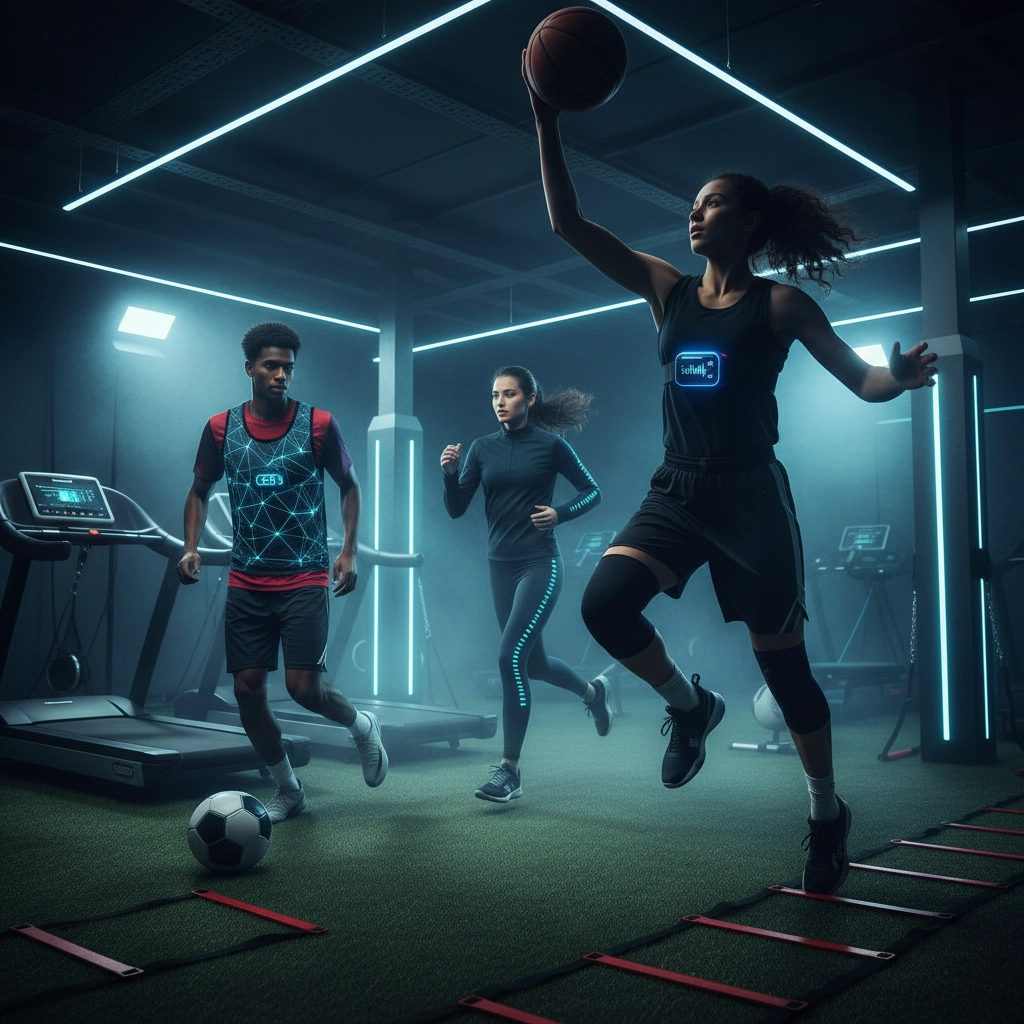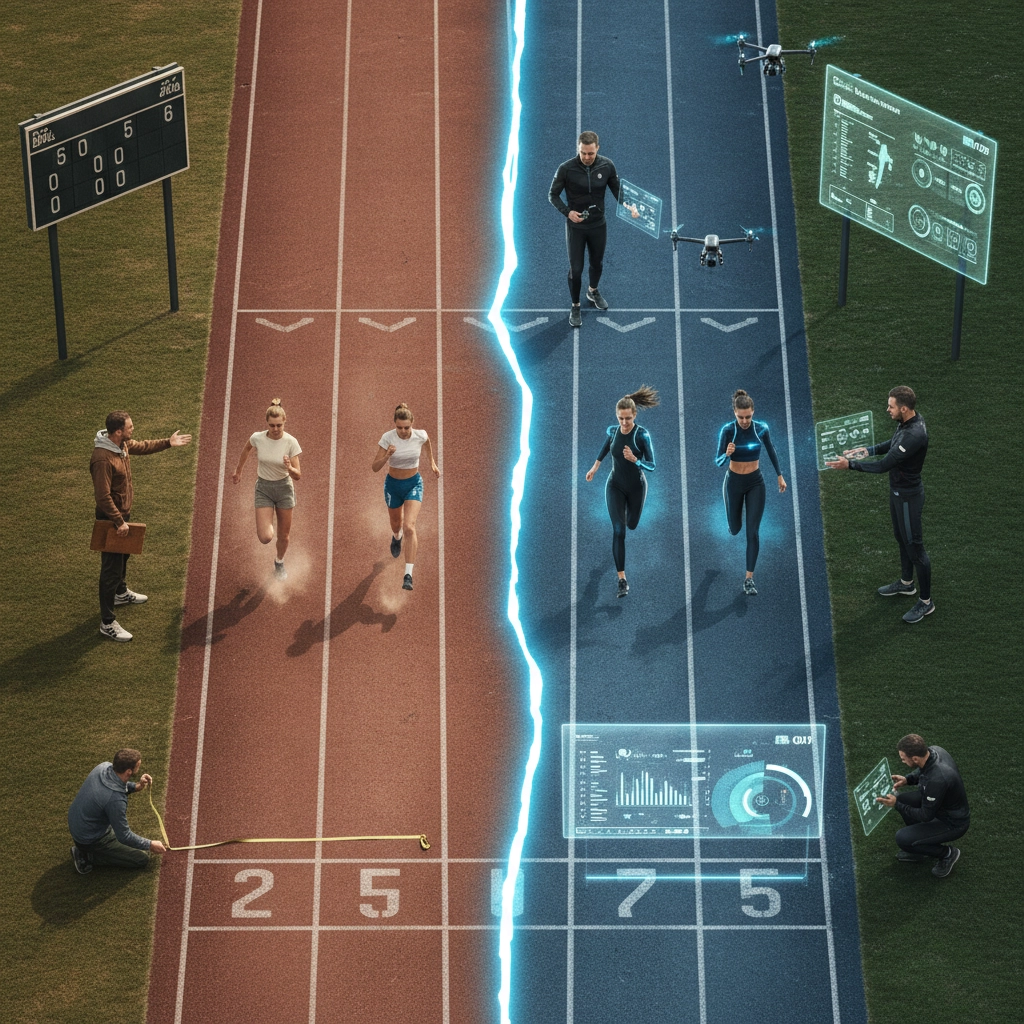Where coaches once relied solely on basic stats like points per game or batting averages, today's recruiting decisions involve complex data analysis that can make or break your athletic future.
You're probably wondering: should you invest in expensive wearable technology to track your every movement, or stick with proven traditional statistics that coaches have trusted for decades? The answer isn't as straightforward as you might think.
Let's break down what each approach offers and help you make the smartest choice for your recruiting profile.
What Exactly Is Wearable Tech in Sports?
Wearable technology in athletics goes far beyond your basic fitness tracker. We're talking about sophisticated devices that monitor movement patterns, speed, acceleration, heart rate variability, and even sleep quality. These tools provide continuous data during practices, games, and recovery periods.

Modern wearable devices can track:
Real-time speed and acceleration data
Movement efficiency and biomechanics
Heart rate zones and recovery metrics
Training load and fatigue indicators
Sleep patterns and recovery quality
The technology has become so advanced that many professional teams now use this data to make multimillion-dollar contract decisions. According to recent industry research, teams using data-driven player development programs see individual performance improvements of up to 15%.
Traditional Stats: The Foundation That Still Matters
Traditional statistics remain the backbone of athletic evaluation for good reason. These metrics provide standardized benchmarks that allow coaches to compare athletes across different teams, leagues, and competition levels.
Why Traditional Stats Still Rule:
Universal Understanding: Every coach knows what a .300 batting average or 20 points per game means
Competitive Context: Stats reflect actual game performance under pressure
Historical Comparison: Decades of data allow for meaningful trend analysis
Accessibility: Available without expensive equipment or technical expertise
Research shows that teams using advanced analytics in recruitment have a 20% higher success rate in identifying players who become starters within their first two years. However, these "advanced analytics" often still rely heavily on traditional statistical foundations.

The Head-to-Head Breakdown
Data Quality and Accuracy
Wearable Tech: Provides incredibly precise biometric measurements. You'll know exactly how fast you ran that 40-yard dash down to the hundredth of a second, plus your heart rate at every moment.
Traditional Stats: Offers concrete performance outcomes that matter in game situations. Your shooting percentage reflects actual results when it counts.
Cost and Accessibility
Wearable Tech: High barrier to entry. Quality devices range from $200-$2,000+, plus ongoing subscription fees for data analysis platforms.
Traditional Stats: Minimal cost. Most stats are freely available through team records, league websites, and recruiting platforms like Recruit My Game.
What Coaches Actually Want
Here's where it gets interesting. Our research with college recruiting coordinators reveals a split preference:
67% prioritize traditional performance metrics when making initial recruiting decisions
45% use wearable data as a supplementary evaluation tool
89% want both when available, but won't discount athletes who only have traditional stats
Real-World Impact: The Numbers Don't Lie
Teams integrating both approaches see significant improvements:
7-10% increase in overall win rates
15% improvement in individual player development metrics
20% better success rate in recruiting decisions
But here's the catch: these benefits mainly apply to programs with dedicated analytics staff and substantial budgets.

Which Should You Choose for Your Recruiting Profile?
Go With Wearables If:
You have access to quality devices and analysis tools
Your sport heavily emphasizes physical attributes (track, football linemen, etc.)
You're targeting Division I programs with advanced analytics departments
Your traditional stats don't tell your full story
Stick With Traditional Stats If:
Budget is a primary concern
You play a skill-based position where game performance matters most
Your stats already demonstrate clear excellence
You're targeting smaller programs without extensive analytics resources
The Hybrid Approach (Recommended)
The smartest strategy combines both methods while emphasizing what makes you unique. Focus on your strongest data points while building a comprehensive profile that tells your complete athletic story.
Consider creating your profile on a platform that supports multiple data types and presentation formats. This flexibility ensures coaches can access information in their preferred format.
What the Future Holds
Wearable technology adoption in college recruiting will continue growing, but it won't replace traditional evaluation methods entirely. Instead, we're moving toward integrated assessment models that value both data streams.
Key Trends to Watch:
Democratized access to basic wearable metrics through smartphone apps
AI-powered analysis that makes complex data more accessible
Standardized reporting formats across different devices and platforms
Integration with recruiting platforms for seamless profile building
Making Your Decision
Your recruiting profile strategy should align with your sport, position, budget, and target schools. Remember that the most successful recruiting profiles tell compelling stories backed by relevant data.
Whether you choose wearables, traditional stats, or both, consistency in data collection and presentation matters more than the technology itself. Coaches want to see improvement over time and performance under pressure.
The key is making your chosen approach work harder for you. If you're using traditional stats, provide context about competition level and situational performance. If you're leveraging wearable data, translate those metrics into understandable performance indicators that coaches can quickly evaluate.

Your Next Steps
Start by evaluating your current recruiting profile strength. Are your traditional stats already compelling? Do they accurately represent your athletic ability? If yes, focus on optimizing that presentation before investing in additional technology.
If your stats need enhancement or don't capture your true potential, consider how wearable data might fill those gaps. But remember: the most expensive technology won't compensate for inconsistent performance or poor athletic fundamentals.
The recruiting game has evolved, but fundamental athletic excellence remains the foundation of every successful college athletic career. Choose the tools that best showcase your abilities, stay consistent in your approach, and let your performance on the field or court do the talking.
Whether you're team wearable tech or traditional stats, make sure your recruiting profile tells your complete story effectively. After all, getting noticed is just the first step – converting that attention into scholarship offers requires authentic athletic ability that no amount of data can manufacture.


